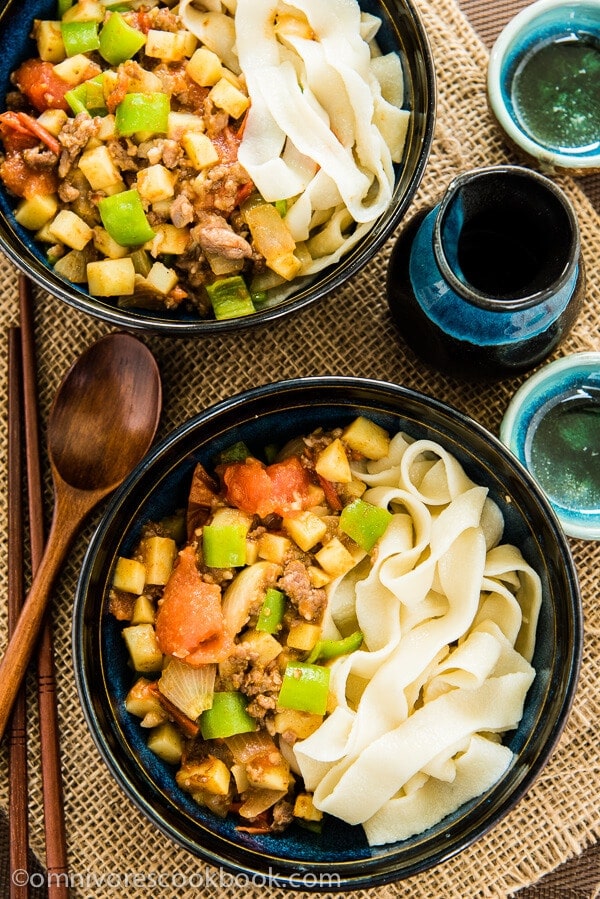
The tender ground lamb meat is cooked with potato, tomato, onion, and pepper to create a simple, colorful, and delectable noodle sauce. It is then poured on freshly boiled handmade noodles to make a delicious and healthy one-dish-meal.
I’m always amazed by the fact that the variety of noodle dishes in China is practically limitless. Not to mention there are eight types of mainstream cuisine, 23 provinces with completely different cooking styles, and 611 cities, each with its own specialty. Even two families living next door to one another have their own opinions towards cooking a given noodle dish, and might serve it in a totally different way.
If you travel to the western part of China, you will always find a type of dish that consists of boiled noodles served with a flavorful sauce. It’s really close to the idea of pasta, but with Chinese style seasoning and noodles. It’s called ban mian (拌面) in general terms, lo mein in Cantonese cuisine, and laghman in Xinjiang cuisine.
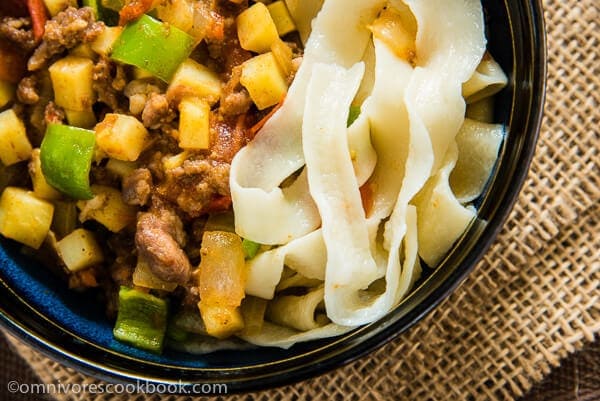
You might be familiar with the term lo mein. But today I would like to introduce a different way to enjoy noodles – the Uyghur style.
If you ever look at the general introduction of the Xinjiang region in my last post, you’ll find that Uyghur food bears a lot of similarities to Middle Eastern cuisine, and laghman is no exception. The main ingredients of the noodle sauce are lamb, potato, onion, tomato, and pepper. They are cooked with very simple yet flavorful spices – cumin and white pepper – to create a mouthwatering sauce. It is then poured on freshly boiled noodles, creating a healthy and fulfilling dish.
The whole idea of this dish is simplicity and great flavor at a low budget.
To create the perfect Laghman, using hand-pulled noodles is a necessity. Don’t let the name scare you off, though. I wrote a thorough post with a foolproof hand-pulled noodle recipe and you’ll be able to nail it on the first try.
Of course, you can always use other types of noodles in this dish. Fresh Chinese noodles will be a great choice, but I also found dried udon noodles work well, too.
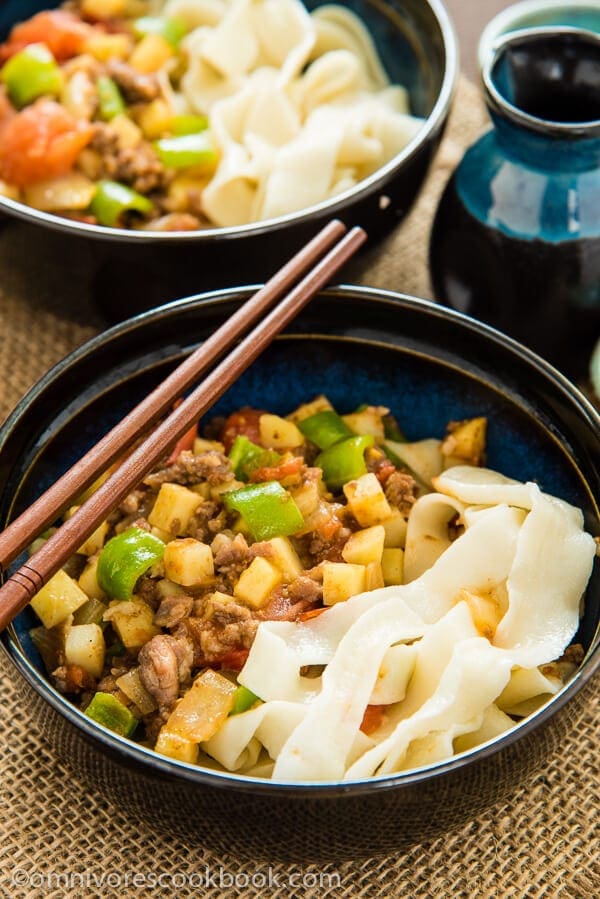
This is a really simple dish, but just take note of a few things:
- Chop the veggies into small cubes, so they will be better seasoned and easy to cook through during the stir-frying.
- Mix the ground lamb with cornstarch. It will help tenderize the meat and keep it moist during cooking.
- Serve a small portion of noodles with a generous amount of sauce. I always prefer to keep the ratio of noodle and sauce at 1:1. Not the authentic way, but more delicious!
That’s not so many things to remember, right? Because it’s such an easy dish!
By the way, one last word about enjoying this dish the authentic way. If you go to a Xinjiang restaurant, you’ll see Chinese black vinegar, chili oil, and raw garlic arranged neatly on the table. To eat the dish like a local, drizzle some vinegar and chili oil to mix with the sauce and noodles, and alternate between eating the noodles and taking bites from a chunk of raw garlic. I personally like to pour vinegar and chili oil onto the noodles, but am not a big fan of the garlic part 😉
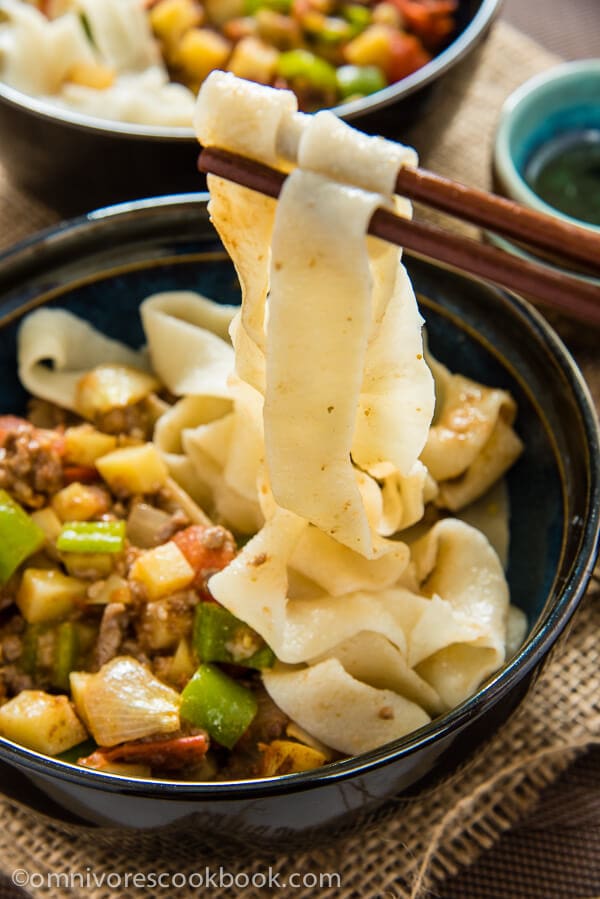
Do you like my recipe? Sign up for the Omnivore’s Cookbook weekly newsletter to have the latest recipes delivered to your inbox and get a FREE e-cookbook!
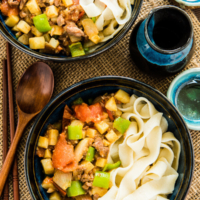
Uyghur-Style Noodles with Lamb Sauce (Laghman, 新疆拌面)
Ingredients
- 150 grams 5 ounces lamb leg meat or ground lamb meat (lean fat ratio 7:3)
- 2 teaspoons cumin powder
- 2 tablespoons vegetable oil
- 1 teaspoon salt
- 1/2 teaspoon white pepper powder
- 2 teaspoons cornstarch
- 1/2 80 grams / 3 ounces small onion, cubed
- 1 200 grams / 7 ounces small potato, cubed
- 1 200 grams / 7 ounces tomato, chopped
- 1 50 grams / 2 ounces chili pepper (or bell pepper), cut to square
- 200 grams 7 ounces uncooked hand-pulled noodles (or 2 servings dried / fresh noodles)
Instructions
- Cube lamb leg into 1-centimeter (0.4-inch) cubes (or use ground lamb directly) and add them to a small bowl. Add 1 teaspoon cumin powder, 1 teaspoon vegetable oil, 1/2 teaspoon salt, the white pepper, and the cornstarch. Mix well and allow to marinate at room temperature for about 15 minutes.
- While marinating the lamb, prepare the vegetables. Try to cut the onion and the potato the same size as the lamb cubes.
- Add water to a large pot and bring to a boil (for cooking the noodles) . Prepare the sauce while boiling the water.
- Heat 1 tablespoon oil in a large nonstick skillet (or a wok) over medium heat (medium high heat if using an electric stove) and swirl to coat the bottom of the wok with oil. When the oil becomes warm, add lamb. Stir and cook until the surface turns light brown but the meat is still raw inside, about 2 minutes. Transfer the lamb to a plate and set aside. Save the oil in the skillet.
- Prepare a small bowl of water and set aside.
- Add the remaining 2 teaspoons oil (or less) until the oil in the skillet is about 1 tablespoon. Add onion and stir and cook for 1 minute. Add potato and stir a few times. Swirl in 2 tablespoons water to speed up the cooking. Continue to stir and cook until the potato is slightly charred, 3 to 4 minutes. Add tomato, the remaining 1/2 teaspoon salt and the remaining 1 teaspoon cumin powder and mix a few times.
- Add back lamb and stir to mix well. Add chili pepper (or bell pepper) and keep stirring until cooked through. Stop heat and transfer the sauce to a large bowl.
- Cook noodles according to the instructions.
- Add noodles to serving plates and pour the sauce on top. Serve immediately.
The nutrition facts are generated from 1 of the 2 servings generated by this recipe.
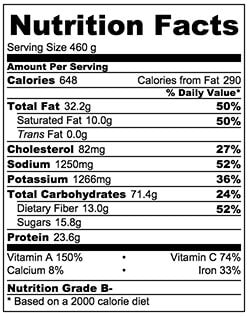

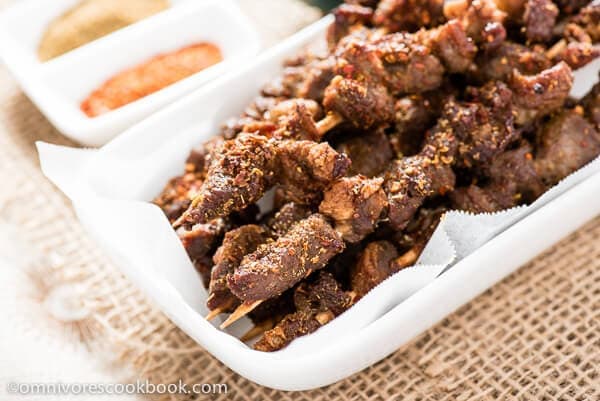













Maggie, I still can’t believe you made these gorgeous noodles by hand!!! WOW!! I love this! I could eat Asian noodle dishes all week!
Gorgeous homemade noodle dish and love that sauce. There is something about homemade noodles that makes me want seconds…
These noodles look gorgeous! I love that you made them by hand, so impressive! I could eat noodles all the time, this looks mouthwatering!
Love these noodles, so delicious! And the sauce sounds amazing! Great post and step by step photos Maggie! pinned!
You cook the best food Maggie! I’ve got to try this!
All these lamb Chinese dishes you share are fascinating to me. I so do not associate lamb with Chinese food – I have never seen it in Australia and I didn’t travel to the northern/western regions in China. The flavours are honestly like Middle Eastern – but with noodles! Adore adore adore!!
YUM, I love lamb, but like Nagi I also do not associate lamb with China! They must have many lamb breeders? as you have quite a few lamb recipes. Your noodles look amazing, nothing a store bought noodle could replicate. HAPPY CHINESE NEW YEAR- enjoy time with all your loved ones!
Lisa Smithey
PS. Maggie, whenever I go to my favorite Asian market I see cleavers, as in MEAT cleavers. Are these a huge part of your daily use in cooking? They are not super expensive, I just don’t know if I need one, what do you think?
Hi Lisa, Happy Chinese New Year to you and your family!
Lamb is not often seen in southern Chinese cooking, but in northern, middle and west parts of China, it’s a very popular meat. And it’s the main source of protein for the large Muslim population in these areas. I will post a few more lamb recipes soon (to celebrate the year of the sheep), hope you’ll like them 🙂
Yep, meat cleaver is a must have for almost every Chinese family. Even for cutting veggies, some people prefer to use it over chopping knife. Also because we really like cooking with bone-in meat, so a cleaver comes in handy when you need to chop raw or cooked bone-in chicken, or pork ribs. About whether to buy one or not, it’s really depend on how you like the food prepared. If you like authentic Asian flavor and would like to cook with bone-in meat, I suggest you to get one 🙂
Wow, I’m not so keen on the garlic-chomping part either, Maggie, but I LOVE the sound of everything else! You are showing me how simple Chinese food can be and I LOVE that, too!
Oh my, this looks amazing! Give me a big bowl of noodles, and I’m a very happy woman. I love the all of the incredible flavors in this dish. It’s so interesting to see lamb – like Nagi said, I never really associated lamb with Chinese cuisine. Very interesting!
What an incredibly flavorful dish and so satisfying! I love learning so much about authentic Chinese food from you, Maggie!
Maggie, I could eat this dish for dinner every single day. A perfect, healthy comfort food that’s easy to prepare yet so full of flavour. I have been pondering buying some lamb for some time now and I will do it this weekend and cook this dish. It’s calling to me! I can get ground lamb at the organic farm, that would be ok, right?
I can hardly wait to taste this. Great recipe!
Organic lamb sounds so fancy! Yep, the ground lamb will work perfect for this dish! Let me know how the dish turn out. Happy cooking! 🙂
So loving this dish. Lamb is big in my house and your tip with the cornstarch is one I will start to implement. Thanks!
Thanks for stopping by Kevin! Yep, the cornstarch thing is really helpful and I use it for all my stir fried meat dishes. Glad it’s helpful 🙂
Maggie, this sounds really good! At first it seemed strange to me that there were no liquid components in the recipe, like soy sauce or vinegar or the like, but I’m assuming that this makes the vinegar and chili oil drizzle at the end a pretty crucial part of the dish, no? The combination of all of the ingredients in the main recipe sounds very delicious and intriguing to me, so I will likely be trying this soon…well, as soon as I can get my hands on some black vinegar! I just made a big batch of your chili oil to put in the fridge for when that day rolls around. Thanks for the inspiration, and the bit of history/culture in your description! I hope you have a great day! 🙂
Hi Jason, the original recipe I learned from used a relatively dry sauce. The tomato will release some liquid after cooking though. Yes, the vinegar and chili oil is a crucial part, and I know some people will add a LOT. If you just want to try out the noodle sauce and do not have black vinegar at home, you can add a bit chicken stock at the end of cooking. And then serve it with chili oil, I bet it’ll be super delicious too.
Happy to hear you like my chili oil recipe and my blog 🙂 You too, have a great week ahead!
Hi your photo shows that you’ve added celery but it’s not in your ingredients list?
The green veggie in the pictures are peppers, not celery.
I just found your blog and I am absolutely in love! My husband and I lived in XinJiang for a year and we sincerely miss XinJiang styled food. Thank you so much for sharing these creations, I can’t wait to recreate them in the States!
I found your uygur noodle Recepy. It’s different from the restaurant I eat.well I will try n error then
Thank you